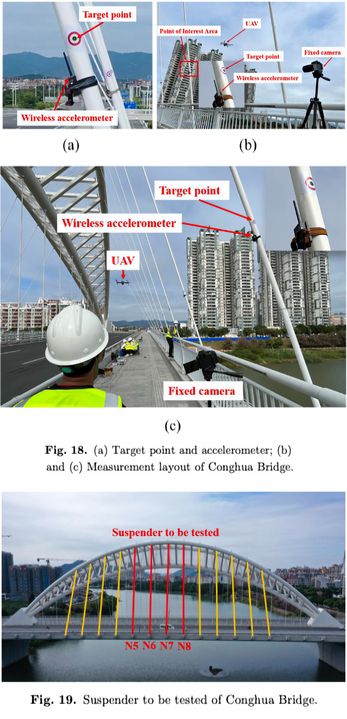
Our Research
Seeing the Invisible: UAV-Enabled, Vision-Driven Non-Destructive Testing
Our group engineers agile sensing systems—UAVs, vision, MEMS arrays—to capture high-fidelity motion, stress and vibration data that traditional gauges miss.
This page is still under construction

Themes in our work
UAV Vision Metrology
CNN-corrected optical flow tracks sub-millimeter displacements from stand-offs > 30 m, unlocking rapid bridge surveys with no scaffolding.

Cable & Stay Monitoring
EMD-cleaned signals reveal natural frequencies and forces without installing accelerometers, enabling fully non-contact inspections.

Signal Correction & Denoising
Bayesian optimization and spectral filtering purge UAV ego-motion, delivering lab-grade data from harsh field environments.

Explore a few of our latest projects:



Featured Project
Measurement of Bridge Vibration by UAVs Combined with CNN & KLT Optical Flow
A measurement method of bridge vibration by unmanned aerial vehicles (UAVs) combined with convolutional neural networks (CNNs) and Kanade–Lucas–Tomasi (KLT) optical-flow method is proposed.
In this method, the stationary reference points in the structural background are required, a UAV is used to shoot the structure video, and the KLT optical-flow method is used to track the target points on the structure and the background reference points in the video to obtain the coordinates of these points on each frame. Then, the characteristic relationship between the reference points and the target points can be learned by a CNN according to the coordinates of the reference points and the target points, so as to correct the displacement time–history curves of target points containing the false displacement caused by the UAV’s ego-motion. Finally, operational modal analysis (OMA) is used to extract the natural frequency of the structure from the displacement signal. In addition, the reliability of UAV measurement combined with CNN is proved by comparing the measurement results of the fixed camera and those of UAV combined with CNN, and the reliability of the KLT optical-flow method is proved by comparing the tracking results of the digital image correlation (DIC) and KLT optical-flow method in the experiment of this paper.

Featured Project
Cable Force Estimation Method Based on UAVs and EMD
To solve the problems of difficulty in deploying accelerometers in traditional cable force measurement, this paper proposes a cable force measurement method based on unmanned aerial vehicles (UAVs).
This method first uses the Kanade-Lucas-Tomasi (KLT) optical flow method to track the vibration video of the bridge cable target points captured by the UAV, obtaining its displacement-time-history curve. Then, the empirical mode decomposition (EMD) is used to correct these curves to obtain the true displacement response of the target points. Finally, the operational modal analysis (OMA) is used to obtain the natural frequency of the cable from the displacement response, and the cable force is calculated accordingly. The experimental results show that the relative deviation of the measured natural frequency of the cable is within 5% compared with fixed cameras and accelerometers, indicating that the UAV can effectively obtain the natural frequency of the bridge cable and calculate the cable force.


Featured Project
A Bridge Vibration Measurement Method by UAVs Based on Bayesian Optimization & CNNs
A bridge vibration measurement method by Unmanned Aerial Vehicles (UAVs) based on a Convolutional Neural Network (CNN) and Bayesian Optimization (BO) is proposed.
In the proposed method, the video of the bridge structure is collected by a UAV, then the reference points in the background of the bridge and the target points on the bridge in the video are tracked by the Kanade-Lucas-Tomasi (KLT) optical flow method, so that their coordinates can be obtained. The BO is used to find the optimal hyperparameter combination of a CNN, and the CNN based on BO is used to correct the bridge displacement signal collected by the UAV. Finally, the natural frequency of the bridge is extracted by processing the corrected displacement signals with Operational Modal Analysis (OMA). Moreover, a steel truss is used as the experimental model. The number of reference points and the shooting time of the UAV with the optimal correction effect of the BO-based CNN are obtained by two groups of comparative experiments, and the influence of the distance between structure and reference points on the correction effect of the BO-based CNN is determined by another group of comparative experiment. The static reference points are not required for the proposed method, which evidently enhances the applicability of UAVs; the conclusion of this paper has great guiding significance for the actual bridge vibration measurement.




